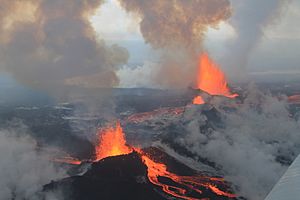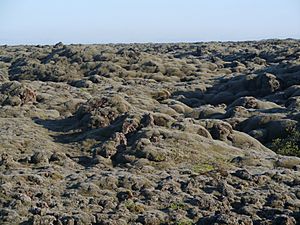Fissure vent facts for kids
A fissure vent is like a long crack in the ground where lava comes out. Think of it as a special kind of volcano that isn't shaped like a cone. These cracks are usually straight, a few meters wide, and can be many kilometers long! When lava flows out of a fissure vent, it can cover huge areas, forming what are called lava floods. Over time, as the eruption slows down, smaller craters might form along the crack.
Volcanoes in Iceland
In Iceland, many volcanic cracks, or fissures, open up in lines. These lines are often parallel to the rift zones where the Eurasian and North American tectonic plates are slowly pulling apart. This area is part of the Mid-Atlantic Ridge, a huge underwater mountain range.
When new eruptions happen in Iceland, they usually come from new cracks that are a bit offset from the old ones. Because so much fluid lava flows out, it often builds up a thick plateau of lava instead of a single tall volcano. However, there are also central volcanoes in Iceland, which are more like traditional cone-shaped volcanoes. These have formed over thousands of years and have their own systems of cracks connected to magma deep underground.
One of the biggest lava eruptions in recorded history happened at the Laki fissures in Iceland. This event, which was part of the Grímsvötn volcanic system, released about 12–14 cubic kilometers of lava! Another huge fissure eruption, called the Eldgjá eruption, happened around 934-940 AD. It was part of the Katla volcanic system and released about 18 cubic kilometers of lava. More recently, in September 2014, a fissure eruption occurred at Holuhraun, which was part of the Bárðarbunga volcanic system.
Fissure Vents in Hawaii

The volcanoes in Hawaii also have fissure vents that spread out from their centers. When lava erupts from these cracks, it can create amazing "curtains of fire" as lava fountains shoot up along the fissure.
These eruptions build up low walls of rock called spatter ramparts on both sides of the crack. If the lava fountains are more spread out along the fissure, they can form rows of small spatter cones and cinder cones. The main difference between them is how hot the lava fragments are when they land. In a spatter cone, the fragments are hot and soft enough to stick together. But in a cinder cone, the fragments are cooler and stay separate.
Images for kids
-
Lava channel on Hawaii
See also
 In Spanish: Fisura volcánica para niños
In Spanish: Fisura volcánica para niños








